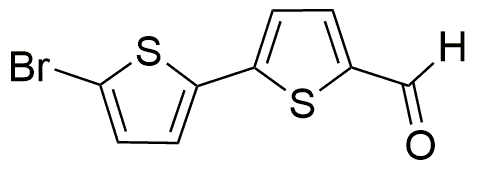5-Bromo-2,2'-bithiophene-5'-carboxaldehyde is widely utilized in research focused on:
- Organic Electronics: This compound serves as a key building block in the synthesis of organic semiconductors, which are essential for developing flexible and lightweight electronic devices such as organic light-emitting diodes (OLEDs) and organic photovoltaic cells.
- Material Science: Its unique properties make it suitable for creating advanced materials with tailored electronic and optical characteristics, which are crucial in the development of sensors and other electronic components.
- Pharmaceutical Research: The compound can be used in the synthesis of novel pharmaceutical agents, particularly in the field of drug discovery, where its structural features may lead to the development of new therapeutic compounds.
- Polymer Chemistry: It is employed in the production of conductive polymers, which have applications in various fields, including coatings, batteries, and supercapacitors, enhancing energy storage solutions.
- Photovoltaic Applications: The compound's ability to absorb light efficiently makes it a candidate for use in dye-sensitized solar cells, contributing to renewable energy technologies.
General Information
Properties
Safety and Regulations
Applications
5-Bromo-2,2'-bithiophene-5'-carboxaldehyde is widely utilized in research focused on:
- Organic Electronics: This compound serves as a key building block in the synthesis of organic semiconductors, which are essential for developing flexible and lightweight electronic devices such as organic light-emitting diodes (OLEDs) and organic photovoltaic cells.
- Material Science: Its unique properties make it suitable for creating advanced materials with tailored electronic and optical characteristics, which are crucial in the development of sensors and other electronic components.
- Pharmaceutical Research: The compound can be used in the synthesis of novel pharmaceutical agents, particularly in the field of drug discovery, where its structural features may lead to the development of new therapeutic compounds.
- Polymer Chemistry: It is employed in the production of conductive polymers, which have applications in various fields, including coatings, batteries, and supercapacitors, enhancing energy storage solutions.
- Photovoltaic Applications: The compound's ability to absorb light efficiently makes it a candidate for use in dye-sensitized solar cells, contributing to renewable energy technologies.
Documents
Safety Data Sheets (SDS)
The SDS provides comprehensive safety information on handling, storage, and disposal of the product.
Product Specification (PS)
The PS provides a comprehensive breakdown of the product’s properties, including chemical composition, physical state, purity, and storage requirements. It also details acceptable quality ranges and the product's intended applications.
Certificates of Analysis (COA)
Search for Certificates of Analysis (COA) by entering the products Lot Number. Lot and Batch Numbers can be found on a product’s label following the words ‘Lot’ or ‘Batch’.
Numéro de catalogue
Numéro de lot/série
Certificates Of Origin (COO)
This COO confirms the country where the product was manufactured, and also details the materials and components used in it and whether it is derived from natural, synthetic, or other specific sources. This certificate may be required for customs, trade, and regulatory compliance.
Numéro de catalogue
Numéro de lot/série
Safety Data Sheets (SDS)
The SDS provides comprehensive safety information on handling, storage, and disposal of the product.
DownloadProduct Specification (PS)
The PS provides a comprehensive breakdown of the product’s properties, including chemical composition, physical state, purity, and storage requirements. It also details acceptable quality ranges and the product's intended applications.
DownloadCertificates of Analysis (COA)
Search for Certificates of Analysis (COA) by entering the products Lot Number. Lot and Batch Numbers can be found on a product’s label following the words ‘Lot’ or ‘Batch’.
Numéro de catalogue
Numéro de lot/série
Certificates Of Origin (COO)
This COO confirms the country where the product was manufactured, and also details the materials and components used in it and whether it is derived from natural, synthetic, or other specific sources. This certificate may be required for customs, trade, and regulatory compliance.

